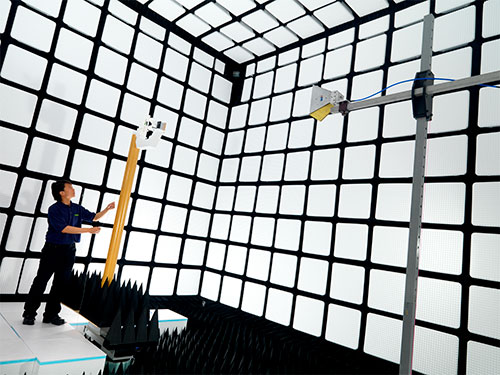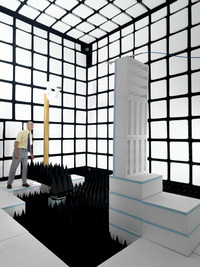SMART is short for SMall Antenna Radiated Testing. The SMART facility is available for minimally-invasive measurements of electrically-small, and smart, antennas at frequencies above 400 MHz. The main challenge was to mount 'omni-directional' antennas to minimise the influence of the antenna support and feed cable.
The SMART range was built for companies and research groups to characterise accurately antennas used for wireless communications applications. These include smaller, often wearable or implantable, devices with small antennas.
This facility will be of interest to you if you are involved in the design, manufacture and use of single and multiple (adaptive and MIMO) array antennas for:

Minimally-invasive measurements: These are achieved by supporting antennas on a thin robust Kevlar tube, or on polystyrene foam blocks. The coaxial cable can be replaced by a miniature RF-to-optical transducer made by Seikoh-Giken. This RF-optical link is so small that it causes minimal disturbance to coin sized patch antennas. It has a metal box 20 mm x 10 mm x 10 mm on which is mounted an SMA connector. The main advantage of the transducer is where the antenna causes common mode current on the feeder coaxial cable that can distort the antenna radiation pattern by typically 10 dB. Replacing the cable by optical fibre addresses this problem. The transducer is part of the opto-electric field sensor system that NPL helped Seikoh-Giken develop.
Four parameters measured: Gain, reflection coefficient, radiation pattern, and efficiency of antennas.
Adaptability: The Kevlar mast that holds the receiving antenna can be replaced by a wooden turntable. The radiation pattern of a body-mounted antenna is measured with a body-phantom or person on the turntable.
 Technical specifications
Technical specificationsDon’t see what you are looking for? Our diverse skill set enables us to provide bespoke solutions. Please contact us to discuss your requirements.
Our research and measurement solutions support innovation and product development. We work with companies to deliver business advantage and commercial success.
Contact our Customer Services team on +44 20 8943 7070